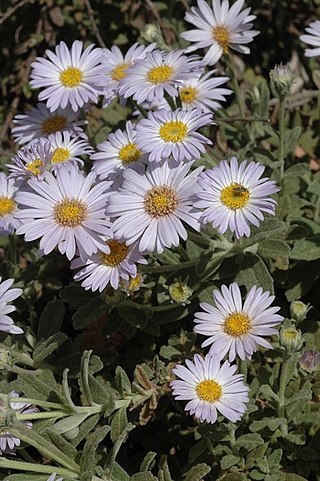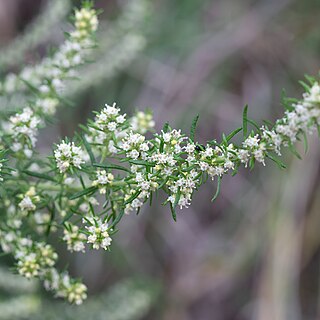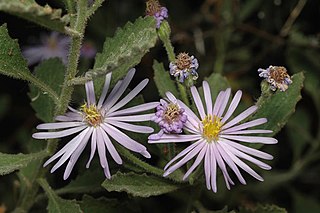
Olearia teretifolia, commonly known as cypress daisy-bush, is a species of flowering plant in the family Asteraceae and is endemic to south-eastern continental Australia. It is a slender, erect to spreading shrub with more or less sessile, linear leaves pressed against the stem, and white and yellow, daisy-like inflorescences.

Olearia axillaris, commonly known as coastal daisy-bush, coast daisy-bush or coastal daisybush is a species of flowering plant in the family Asteraceae and is endemic to coastal areas of Australia. It is an erect, bushy shrub with densely cottony-hairy branchlets, aromatic, linear to narrowly elliptic or narrowly lance-shaped to egg-shaped leaves with the narrower end towards the base and small white and yellow, daisy-like inflorescences.

Olearia stuartii is a species of flowering plant in the family Asteraceae and is endemic arid parts of inland Australia. It is compact, spreading shrub or undershrub with lance-shaped leaves and blue to mauve and yellow, daisy-like inflorescences.

Olearia asterotricha, commonly known as rough daisy-bush, is a species of flowering plant in the family Asteraceae. A tall shrub with white, mauve or blue daisy like flowers growing from the Blue Mountains in New South Wales to western Victoria, Australia.

Olearia homolepis is a species of flowering plant in the family Asteraceae and is endemic to Western Australia. It is a shrub with linear leaves and white or blue and yellow, daisy-like inflorescences.

Olearia mooneyi, commonly known as pumpkin bush, is a species of flowering plant in the family Asteraceae and is endemic to Lord Howe Island. It is a shrub or small tree with hairy, elliptic to egg-shaped leaves with the narrower end towards the base, and white and pale yellow, daisy-like inflorescences.
Melicope contermina is a species of shrub or small tree in the family Rutaceae and is endemic to Lord Howe Island. It has trifoliate leaves and white flowers borne in leaf axils in panicles of nine to fifteen flowers.

Pimelea congesta is a species of flowering plant in the family Thymelaeaceae and is endemic to Lord Howe Island in Australia. It is a shrub with rough bark, decussate, elliptic leaves and heads of white flowers.

Olearia iodochroa, commonly known as the violet daisy bush, is a species of flowering plant in the family Asteraceae and is endemic to south-eastern continental Australia. It is a shrub with branchlets densely covered with whitish hairs, narrowly egg-shaped leaves with the narrower end towards the base, and white or mauve, and cream-coloured, yellow or blue, daisy-like inflorescences.
Olearia adenolasia, commonly known as woolly-glandular daisy-bush, is a species of flowering plant in the family Asteraceae. It is a small upright shrub with sticky leaves and blue-purple or white daisy flowers.

Olearia magniflora, commonly known as splendid daisy-bush, is a small shrub with clusters of deep mauve to purple flowers.

Olearia oppositifolia is a species of flowering plant in the family Asteraceae and is endemic to eastern Australia. It is a shrub with egg-shaped to elliptic leaves arranged in opposite pairs, and white and yellow daisy flowers.

Olearia exiguifolia commonly known as small-leaved daisy bush, is a species of flowering plant in the family Asteraceae and is endemic to south-western Australia. It is an erect or straggly shrub with broadly egg-shaped leaves with the narrower end towards the base, and white and yellow, daisy-like inflorescences.
Olearia cassiniae is a species of flowering plant in the family Asteraceae and is endemic to the south-west of Western Australia. It is an erect or spreading shrub that typically grows to a height of 0.7–1.8 m and produces white daisy-like inflorescences, mostly between February and April. The species was first formally described in 1865 by Ferdinand von Mueller who gave it the name Aster cassiniae in Fragmenta Phytographiae Australiae from specimens collected by George Maxwell. In 1867, George Bentham changed the name to Olearia cassiniae in Flora Australiensis. The specific epithet (cassiniae) is a reference to the genus Cassinia.

Olearia ferresii is a species of flowering plant in the family Asteraceae and is endemic to central Australia. It is an erect, aromatic shrub with elliptic to lance-shaped leaves and white and yellow, daisy-like inflorescences.

Olearia frostii, commonly known as Bogong daisy-bush, is a species of flowering plant in the family Asteraceae and is endemic to Victoria in Australia. It is a low, often straggling shrub with egg-shaped leaves with the narrower end towards the base, and mauve to pink and yellow, daisy-like inflorescences.

Olearia gravis is a species of flowering plant in the family Asteraceae and is endemic to south-eastern Australia. It is a shrub with elliptic or egg-shaped leaves and white and yellow, daisy-like inflorescences.

Olearia nernstii is a species of flowering plant in the family Asteraceae and is endemic to eastern Australia. It is a shrub with scattered egg-shaped to elliptic leaves with toothed or prickly edges, and white and yellow, daisy-like inflorescences.

Olearia tubuliflora, commonly known as rayless daisy-bush, is a species of flowering plant in the family Asteraceae and is endemic to south-eastern continental Australia. It is a slender, erect shrub with linear or narrowly elliptic leaves and yellow, daisy-like inflorescences but with the ray florets lacking a ligule.

Olearia xerophila is a species of flowering plant in the family Asteraceae and is endemic northern Australia. It is an erect subshrub with elliptic to broadly elliptic leaves and violet, blue or mauve and yellow, daisy-like inflorescences.

















